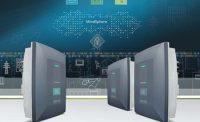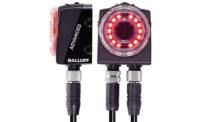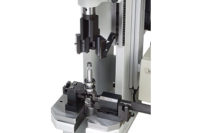New technologies are helping assemblers keep track of product on the line.
Being able to identify parts and assemblies on the line is vital for a number of reasons. It ensures that the right parts are installed in the right products. It helps to keep track of production, inventories and supplies. And, if a problem occurs in the field, it enables manufacturers to fix the issue quickly and comprehensively.
Here’s a look at some of the latest technologies for part marking and automatic identification.
Camera Reads Codes at High Speeds
The Lector85x from SICK Inc. is designed for high performance and maximum throughput in logistics centers. Equipped with a 12.4-megapixel imaging chip, this compact camera offers good depth of field, a wide field of view, and computing power. This means that codes can be reliably identified and correctly assigned to objects, even at speeds of 3.5 meters per second. It can also capture multiple codes at the same time, so fewer cameras are necessary to cover automated sorting processes.
Thanks to the latest imager technology, optimized illumination intensity, optional use of polarizing filters, the camera delivers optimal images regardless of the size and surface of the object, be it a tire, parcel or flat.
Decoding algorithms improved by artificial intelligence ensure that codes can be detected on the object faster and more reliably and that even low-contrast or incompletely detected markings can be decoded reliably. New web-based software enables easy commissioning without prior software installation on the PC.
The steeper mounting angle of the camera reduces shadowing effects, allowing for smaller object gaps. If multiple objects are captured simultaneously, an integrated real-time tracking function ensures 3D tracking of the code within the field of view, thereby correctly assigning codes to the correct objects in each case.
For increased uptime, essential interfaces, the controller, cabling, and data and voltage supply are designed redundantly.
Thanks to its high-speed image and data transmission and good image quality, the camera fulfills all the requirements for transmitting images for optical character recognition and remote video coding, in addition to code reading. Secondary identification is possible with the image data provided.
With selective image transfer and archiving, the process of analyzing unread codes is made much simpler. Package Analytics 4.0 software quickly identifies problems.
The new web-based GUI does not require separate installation of software on the PC; all it needs is a browser. The installation and parameterization interface guides engineers intuitively through the setup menu. Expert knowledge is not required to get the camera ready for operation in the shortest possible time.
For more information, click here.
UHF Read/Write Head Includes IO-Link Processor Unit
Part of Balluff Inc.’s Smart Automation and Monitoring System (SAMS), this UHF read/write head includes an integrated IO-Link evaluation unit.
The head is optimized for close range and reliably detects objects at reading distances of up to 50 centimeters. Its IO-Link interface enables smooth integration by connecting to master network components in the SAMS. Its M30 compact cylinder housing can be easily installed in confined spaces. In addition to reliable identification, the read/write head provides numerous condition-monitoring functions, such as temperature and signal quality monitoring.
The head exceeds the IP69K protection rating and is guaranteed to survive 1,000 cleaning cycles. Made from hygienic stainless steel (1.4404/PBT), the head is resistant to hydrogen peroxide.
For more information, click here.
Laser Bar code Scanner
Able to decode more than a dozen commonly used linear bar code symbols, the TCNM laser scanner from Banner Engineering Corp. provides fast read rates, broad depth of field, and high resolution.
Packaged in a rugged IP65 housing, the device can complete 500 to 1,000 scans per second. Essential setup and diagnostic operations are performed using Smart-Teach push buttons and LED indicators. A code rebuilding algorithm combines multiple scans to reconstruct damaged code information. An oscillating mirror option can be added to improve reliability on varied placement of codes.
GeniusPlus software and proprietary intra-sensor communication protocol eliminate the need for external multiplexer in multisensor setup.
Available in both single-line laser and raster models, it can read bar codes at a range of 40 to 600 millimeters. It can precisely and efficiently read the bar code labels located on shrink wrapped pallets.
For more information, click here.
Pad Printing Machine
The TTN 100 EKO electropneumatic pad printer from Automark can be configured as a one-color machine with an ink cup 90 millimeters in diameter or as a two-color machine with ink cups 65 millimeters in diameter.
The machine has a large illuminated LCD display. All functions are continuously displayed in real-time. For each selected function, a menu mentions what actions must be taken or which buttons must be pressed to control the machine. Four keys in the upper part of the keyboard allow operators to directly reach the requested function.
Engineers can program 25 settings, and all parameters for a particular job can be stored in memory. All setup can be done while the machine is running. The controller includes a cycle counter and a pause function. When the latter function is activated, the machine will automatically scrape the cliché clean at regular intervals to prevent ink from drying. The controller also offers a delay setting, so that ink on the pad can dry for a few seconds for better transfer.
Clichés can be thin steel plates or photopolymer plates. Cliché size can be 100 by 100 millimeters, 100 by 120 millimeters, 100 by 200 millimeters, or 140 by 175 millimeters. Pad stroke is adjustable from 0 to 100 millimeters. Maximum speed is 2,200 cycles per hour with one color.
For more information, click here.
Dot Peen Marker Features Integrated Control Unit
The MV5 Integral from Markator Manfred Borries GmbH is a compact, fully electric dot peen marker with an internal control unit.
The previous model required wiring between the marking head and a control unit located in an external cabinet. The new model does not. Engineers do not need to provide space in a control cabinet for an external controller.
Three models are available, based on the size of the marking field: 65 by 30 millimeters, 85 by 45 millimeters and 120 by 45 millimeters. The 85 by 45 model offers a more stable guidance system than the 65 by 30 model. Double linear guides in the X- and Y-direction guarantee a high repeatability and precise and warp-free marking. The marking head can be mounted in any position and can optionally be protected using a cover.
The marking head weighs approximately 4 kilograms, and it can be mounted to a robot arm. The marking pin can be replaced easily, quickly and inexpensively.
The device can mark materials up to a hardness of 63 HRC. The marking force of the solenoid, which was especially developed for marking purposes, can be adjusted individually to the material and the marking depth. Marking force ranges from 1 to 30 newtons.
Device programming can be done directly via PC-based software. Access to the control is either via the Ethernet interface on the device, which enables control via a company network, or autonomously via the USB-B interface. With an optional display for direct visualization, programming is performed directly on the device using a USB keyboard.
Six LEDs located on the marking head provide information on the unit’s operating status. Also included are four digital I/O, which can be used for synchronization. Several hundred marking files can be stored in the internal memory.
Via the Ethernet TCP/IP program option, the marking system can be integrated into an existing control system, such as a robotic control system, industrial PC or PLC. User data, content data and marking attributes, such as x-y position and character height, can be transmitted. For a simple and fast communication with a PLC, an optional function block can be used. This guarantees a smooth installation into a PLC-driven production line (via the Ethernet-interface).
Also available are plug-in cards for Profibus, Profinet, Ethernet/IP and a card for external power supply for Profinet participants. As for the Ethernet interface, a function block is available for smooth installation in a PLC-controlled production line.
For more information, click here.








